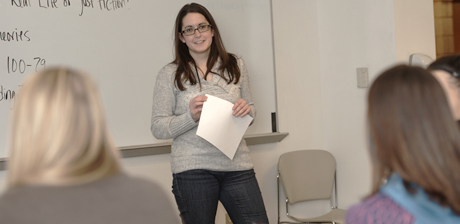October 21, 2014
English prof brings pop culture to classroom
Sure, Kim Lacey is an assistant professor of English. But that hasn’t kept her from dabbling in cognitive psychology.
“I’ve always thought about the sciences and the arts together,” Lacey said. “So I didn’t feel that choosing one meant leaving the other behind.”
That link comes through in some of the courses Lacey teaches: one was called “Memory in Theory and Practice”; another, “The Watchers and the Watched”—a study of the effect of surveillance on human behavior. She even taught a course called “How to Think About Weird Things,” named after a textbook and designed to help students think about the fallacies people stumble over when writing about controversial subjects.
 In short, Lacey is fascinated with the way the human mind works. “But what interests me most is how the brain plays tricks on us,” she said. “We rely on it for everything, so we take it for granted. But all of a sudden it can fool us.”
In short, Lacey is fascinated with the way the human mind works. “But what interests me most is how the brain plays tricks on us,” she said. “We rely on it for everything, so we take it for granted. But all of a sudden it can fool us.”
In fact, before joining SVSU in fall 2011, Lacey had just defended a doctorate about the ways technology can manipulate our memories. In one study she likes to cite, researchers used photo editing software to add participants into photos.
“Then, through a series of interviews, they tell them, ‘Don’t you remember when you went on that balloon ride?’ And they say, ‘No. . . . but I’m in (this photo). I must have done it.’ And over a series of conversations, they end up believing it: ‘Oh, that’s right—I remember that shirt; I remember that happening. I remember it being cold that day.’”
Lacey and her fiancé, Jeff, live in Holly with two dogs: a bichon named Barkley and a Brussels griffon named Jerome.
Outside work, Lacey also writes for Guru Magazine, a paper-free science lifestyle magazine—“It’s science without the lab coats,” she said. “Our mission is really to write about the sciences for the everyday reader. It goes back to bridging my passions for the sciences and humanities and seeing how the two disciplines can talk to each other.”
Those passions found a haven at SVSU, Lacey added. “I’m able to do fun things like those crazy courses I’ve designed, and not face any resistance.”
And in addition to the freedom, there’s the people.
“There are so many smart, active researchers here, but they’re also wonderful teachers. So it’s been a great community to be a part of and thrive in, and it’s a lot of fun, too. That’s a very rare combination in a university.”
